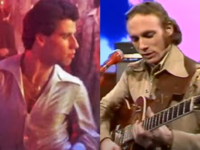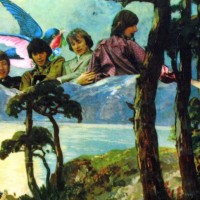Though his bandmate Neil Young is more often fetishized for his contributions to Buffalo Springfield and CSNY, this set makes clear Stephen Stills’ creative depth — as a songwriter, multi-instrumentalist and as a singer.
Featuring 82 tracks from across a 50-year span, with 21 from Stills’ on-going collaborations with David Crosby, Graham Nash and/or Young as well as 11 dating back to his time with Buffalo Springfield, the four-CD Carry On is set for release today via Rhino. Other highlights include 25 previously unreleased tracks; a 1970 collaboration with key influence Jimi Hendrix; remixes of moments like the title track (with a stunning new guitar aside) and of “Change Partners” (with its memorable contribution on pedal steel by Jerry Garcia); and live performances through to CSN’s most recent tour.
Even now, with all of it laid out on Carry On, it’s difficult to comprehend the leap that Stills makes from the timid folkie copycat on very early songs like “Travelin'” (recorded when he was just 17) to the vivid, brutal truth telling that surrounds “For What It’s Worth,” his breakout moment with Buffalo Springfield from just five years later. It would be the first, however, of many such leaps.
Rather than setting a template for his own muse, the military kid who never stayed in any place too long continued to follow his own roving muse. He remained a restless musical sojourner, a tireless troubadour who moved on to CSN and then to create a series of solo efforts that often bore little resemblance to anything that had come before.
Carry On, by pulling together all of Stills’ career highlights and situating them with pieces designed to give broader context, illuminates more fully these many paths. There has been, over time, nothing he couldn’t sing, nothing he wouldn’t take on. Eventually, Stills’ vast catalog came to embody Americana’s quivering melancholy and the rambunctious frivolity of Latin music, rock’s scalding anger and the carnal hunger of soul music.
You also hear anew with Carry On the way his narratives, and his voice, played every bit as important a role in Stills’ journey as did his rightly praised guitar work. In fact, I came in ready to praise the fleet, biting misery of his take on Robert Johnson’s “Crossroads,” the yearning emotional sweep of “Woodstock,” the controlled psychedelia of his wah wah on “Jet Set.” (And that’s to say nothing of his work on the the B-3 or on the bass, heard on literally dozens of songs here.)
But I kept coming back to the larger themes here, and how they allowed Stills to set depth charges to every successive set of expectations. Just when you thought he was an R&B stoked protest singer (“For What It’s Worth”), he’d reappear with an episodic, deeply personal narrative (“Suite: Judy Blue Eyes”), then a Carribbean-flavored kiss off (“Love the One You’re With”), then a searching backwoods lament (“Southern Cross”). These, surely, are Still’s most famous songs, and had they been created by four separate artists, few would have been surprised.
Stills holds them together with a force of will that centers on his voice, both literally and figuratively, which in turn springs from his own complex story. Stills spent his vagabond youth amidst the blues-imbued shotgun shacks of Louisiana and the tumultuous rhythms of Central America. Some part of those cultures was in his sound almost from the beginning, and remains extant today. Carry On connects the dots.
Demos sprinkled throughout provide interesting glimpses into Stills’ creative process, threads that move through the whole collection. For instance, musical experiments found within an early take on “49 Reasons” later show up in full flight on “Pre-Road Downs.” The beginnings of “The Treasure” can be heard during sessions for Stephen Stills 2, some three years before its inclusion on the deeply underrated eponymous Manassas debut from 1972.
They complete this portrait of a restless figure, someone who helped kick open the door for country rock, for world music, for the singer-songwriter movement, for Latin rock — and somehow did so without drawing the rabid fanbase that followed his erstwhile co-hort Young. Maybe Carry On can finally right that wrong. If nothing else, however, it provides a road map for those who never knew just how far Stephen Stills has traveled.
- Nick DeRiso’s Best of 2015 (Rock + Pop): Death Cab for Cutie, Joe Jackson, Toto + Others - January 18, 2016
- Nick DeRiso’s Best of 2015 (Blues, Jazz + R&B): Boz Scaggs, Gavin Harrison, Alabama Shakes - January 10, 2016
- Nick DeRiso’s Best of 2015 (Reissues + Live): John Oates, Led Zeppelin, Yes, Faces + others - January 7, 2016





Stephen Stills was always underrated. Not only was he a way much better singer than Neil Young, his songs were more sophisticated to boot. Young Couldn’t have written “Suite Judy Blue Eyes” if he tried. IMHO he was the man CSN (&Y) couldn’t exist without. His solo stuff not got theaattentionit deserved.
oh yeah?!! and Stills couldn’t have written “T-Bone.” so there! 😉
“The new album Carry On by Stephen Stills is THE BEST FRIGGIN’ THING EVER MADE BY ANYONE EVER!!!!!!!! And any one who thinks otherwise is a purply blue dingbat!!!!!!!!”
……… sorry – that escaped from the Robert plant review.
I wrote some stuff on the Stills’ box this morning, but it got disappeared before I could send it. So, briefly:
“Stills holds them together with a force of will that centers on his voice.” You nailed it right here, Nick. This is it in the most concise, subtle and accurate way possible, and it certainly sums up Stills’ career. There are times where Crosby and Nash might have been mistaken for lightweights, and Neil Young isn’t always around, but I don’t think anyone ever considered that Stills was a lightweight compared to anyone at anytime.
The scope of the box is huge – it has some essential tracks and some unreleased tracks. Two things got missed, I think: first – the long version of Springfield’s “Bluebird” didn’t turn up. Second – i think Stills’ Manassas recordings are the equivalent of Neil Young’s work with Crazy Horse. Here, Stills gets to be the band leader – not the solo artist; and not the co-competitor he was with Young in the Springfield; and not a member of the “Equal amongst equals” supergroup that couldn’t come up with a band name better than one that reads like a yellow pages phone directory entry found under “Barristers and Solicitors.”
That first 2 LP set by Manassas was great, as was the follow up and the Manassas unreleased tracks collection that came out a few years back. Highly underrated, as noted.
So……… when does the Nash box come out?
Mr. Nash’s box set came out in 2009.
Nash box was out in 2009? I guess I’ll have to track that down as well……….. apparently it flew in under my radar.
I agree with Charlie…Stills’ best songs are better than Neil’s best. Neil is often heralded as being so diverse; but he doesn’t come close to Stills (rock, folk, blues, Latin, r&b, country, jazz). He also made other people’s songs better (teach your children, Woodstock, long time gone, wooden ships, Ohio, helpless, Marrakech express…) as a great arranger and musician. He’s got soul.
Still is a genius, plain and simple. So is Neil Young. Why can’t we have two teams on top–this isn’t the Yankees v. Red Sox. They compliment each other.
I agree. Both are great. Just can’t stand the ignorant media with their same old stance. Both artists had their ups and downs.
You’re both arguing a point that wasn’t made. I never said one was better than the other.
As they didn’t name you in particular, Nick, hopefully they meant simply the media in general over the years. Your position on the Carry On box set is in fact that Stills somehow never did draw “the rabid fanbase that followed his erstwhile co-hort Young [and maybe] Carry On can finally right that wrong.”
I remember Stills himself once said in an interview I read years ago, something along the lines of, “You know what would be a great song? Something where Neil wrote the words and I wrote the music.” Stills had no fear of making big statements – he always knew that he himself was the equal of Neil Young – they just had strengths in diifferent areas.
I wasn’t referring to Nick’s article…just frustrated by several others that I read recently re: Stills’ playing second fiddle to Neil since the mid 70’s. I was agreeing with Charlie -saying that I think Stills best is better-my own opinion FWIW. No disrespect to Nick. He demonstrated more knowledge on the subject than most articles that I have seen.
If asked to express a preference, my automatic reaction would be to say I like Young more than Stills. But if I think about it honestly I’m pretty sure over the course of any given year, I listen to more Stills, CSN and Manassas than Young, CSNY and Young with Crazy Horse. I think Neil has maintained a higher profile, released more music, and taken more chances, which resulted in stunning highs and bizarre lows. But Stills has been more consistent from album to album, and his best work is right up there with Young’s best. No – I don’t imagine Stills’ ever played second fiddle to Young; besides I think that unless you count the stand up acoustic bass, fiddle is one of the few instruments that Stills doesn’t play at all.